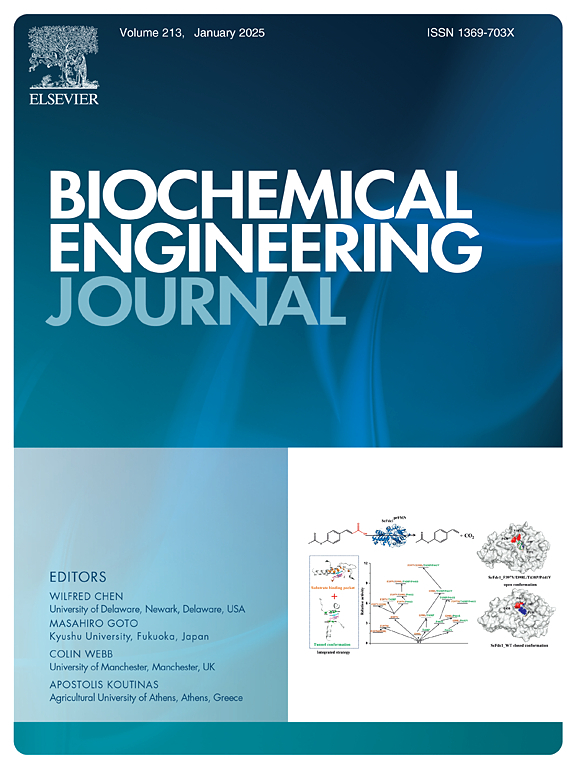Biodegradation of deep eutectic solvent pre-treated natural rubber gloves by Klebsiella aerogenes: A sustainable approach to rubber waste management
IF 3.7
3区 生物学
Q2 BIOTECHNOLOGY & APPLIED MICROBIOLOGY
引用次数: 0
Abstract
This study investigates the potential of deep eutectic solvents (DES) to enhance the biodegradation of natural rubber gloves (NRG) by Klebsiella aerogenes. Choline chloride and urea (ChCl: urea) was the DES employed to pre-treat NRG at various temperatures (80°C to 140°C) and durations (0.5 h to 5 h). Pre-treated rubber (p-NRG) underwent significant physical and chemical changes, enhancing its biodegradability. Analytical techniques such as dry weight analysis, bacteria cell concentration, FTIR TGA, and SEM were used to characterize the pre-treated and biodegraded samples. The results have demonstrated a significant weight loss and structural modifications in p-NRG, with the highest degradation of 43 % observed at 140°C for 5 hours of pretreatment before biodegradation. Meanwhile, merely 17 % of weight loss was observed when pre-treatment was not employed. DES pre-treatment notably enhanced NRG biodegradability, achieving a 50.6 % weight loss when biodegradation was conducted at pH 7 and 35°C. The highest cell concentration, 0.75 g/L, was recorded in the second week of the biodegradation process. Results have indicated that the maximum protein concentration of 697.3 µg/ml, along with the highest enzyme activities for laccase and manganese peroxidase (MnP) at 0.46 ± 0.05 IU and 0.30 ± 0.05 IU respectively, were recorded in the second week of the biodegradation process. DES pre-treatment has significantly improved the biodegradability of NRG by Klebsiella aerogenes, offering a promising and eco-friendly solution for rubber waste management.
产气克雷伯氏菌对深共晶溶剂预处理天然橡胶手套的生物降解:橡胶废物管理的可持续方法
本研究探讨了深共晶溶剂(DES)在增强气肿克雷伯氏菌对天然橡胶手套(NRG)的生物降解方面的潜力。氯化胆碱和尿素(氯化胆碱:尿素)是用于预处理 NRG 的 DES,预处理温度(80°C 至 140°C)和持续时间(0.5 小时至 5 小时)各不相同。预处理后的橡胶(p-NRG)发生了显著的物理和化学变化,提高了其生物降解性。分析技术包括干重分析、细菌细胞浓度、傅立叶变换红外热像仪、热重分析和扫描电镜,用于描述预处理和生物降解样品的特性。结果表明,p-NRG 的重量明显减少,结构也发生了改变,在生物降解前,预处理温度为 140°C,时间为 5 小时,降解率最高,达到 43%。与此同时,在未采用预处理的情况下,仅观察到 17% 的重量损失。DES 预处理显著提高了 NRG 的生物降解性,在 pH 值为 7、温度为 35°C 的条件下进行生物降解时,重量损失率为 50.6%。在生物降解过程的第二周,细胞浓度最高,达到 0.75 克/升。结果表明,在生物降解过程的第二周,蛋白质浓度最高,为 697.3 µg/ml ,漆酶和锰过氧化物酶(MnP)的酶活性最高,分别为 0.46 ± 0.05 IU 和 0.30 ± 0.05 IU。DES 预处理大大提高了 NRG 在产气克雷伯氏菌作用下的生物降解能力,为橡胶废物管理提供了一种前景广阔的生态友好型解决方案。
本文章由计算机程序翻译,如有差异,请以英文原文为准。
求助全文
约1分钟内获得全文
求助全文
来源期刊

Biochemical Engineering Journal
工程技术-工程:化工
CiteScore
7.10
自引率
5.10%
发文量
380
审稿时长
34 days
期刊介绍:
The Biochemical Engineering Journal aims to promote progress in the crucial chemical engineering aspects of the development of biological processes associated with everything from raw materials preparation to product recovery relevant to industries as diverse as medical/healthcare, industrial biotechnology, and environmental biotechnology.
The Journal welcomes full length original research papers, short communications, and review papers* in the following research fields:
Biocatalysis (enzyme or microbial) and biotransformations, including immobilized biocatalyst preparation and kinetics
Biosensors and Biodevices including biofabrication and novel fuel cell development
Bioseparations including scale-up and protein refolding/renaturation
Environmental Bioengineering including bioconversion, bioremediation, and microbial fuel cells
Bioreactor Systems including characterization, optimization and scale-up
Bioresources and Biorefinery Engineering including biomass conversion, biofuels, bioenergy, and optimization
Industrial Biotechnology including specialty chemicals, platform chemicals and neutraceuticals
Biomaterials and Tissue Engineering including bioartificial organs, cell encapsulation, and controlled release
Cell Culture Engineering (plant, animal or insect cells) including viral vectors, monoclonal antibodies, recombinant proteins, vaccines, and secondary metabolites
Cell Therapies and Stem Cells including pluripotent, mesenchymal and hematopoietic stem cells; immunotherapies; tissue-specific differentiation; and cryopreservation
Metabolic Engineering, Systems and Synthetic Biology including OMICS, bioinformatics, in silico biology, and metabolic flux analysis
Protein Engineering including enzyme engineering and directed evolution.
 求助内容:
求助内容: 应助结果提醒方式:
应助结果提醒方式:


